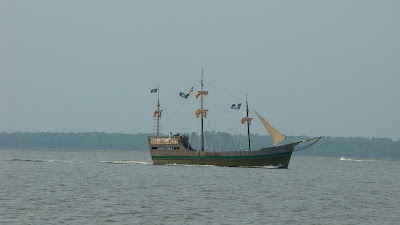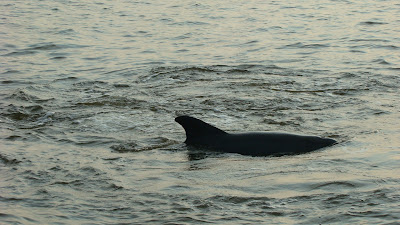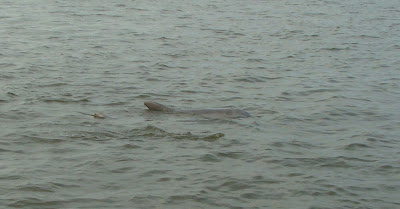Gulf Shores, Alabama
Still "living" at Gulf State Park
I find it kind of humorous that we don't do anything for several days and then we do everything else right in a row. Not on purpose, but it ends up being that way.
We have taken a dolphin search cruise down here in Alabama, in the past: http://chasinrainbowstoo.blogspot.com/2012/04/no-alligators-but-dolphins.html
 This trip, we found another place that does Dolphin cruises, but also does a combination Dolphin and Wildlife Cruise. It is Cetacean Cruises. They take you on a 2 hour cruise (and no, Gilligan, we didn't get lost in a storm, LOL). Their prices are very reasonable, we found a coupon good for $3.00 off each on their website, and the cruise was fantastic.
This trip, we found another place that does Dolphin cruises, but also does a combination Dolphin and Wildlife Cruise. It is Cetacean Cruises. They take you on a 2 hour cruise (and no, Gilligan, we didn't get lost in a storm, LOL). Their prices are very reasonable, we found a coupon good for $3.00 off each on their website, and the cruise was fantastic. The absolute only thing I would change is that although they may be able to "legally" have 46 people on board and I'm sure money wise to cram as many paying passengers on as possible is the "way to go", it would have been a much more enjoyable experience if we had not been packed on like sardines. Being as short as I am, it was very difficult to get good pictures or even to see over many of the other people. I would have had a better
 time with about half as many people on board. 3 people even got off the boat before we left the dock saying it was too crowded for them and I agree, although we stayed on. There were also a couple of men between us and the Captain that were talking sports so loudly I couldn't hear the Captain telling us about the Swamp. The boat we were on is called the Explorer and it is custom made to move efficiently through as little as 2 feet of water, which is why they can go up into the swamps where the water is very shallow.
time with about half as many people on board. 3 people even got off the boat before we left the dock saying it was too crowded for them and I agree, although we stayed on. There were also a couple of men between us and the Captain that were talking sports so loudly I couldn't hear the Captain telling us about the Swamp. The boat we were on is called the Explorer and it is custom made to move efficiently through as little as 2 feet of water, which is why they can go up into the swamps where the water is very shallow.We passed this "pirate" ship. It is owned by a couple of women who plan "pirate adventures" for kids and take them out for a cruise as pirates. It was cute.

We had a fantastic Captain and first mate, Rachel. Our Captain reminded me a lot of my Uncle Kenny, a happy man with a laugh and joke for everything. He and Rachel were both fun and interesting tour guides.
First we learned a lot about the Intracoastal Waterway which goes all the way across the Gulf Coast, from Brownsville, TX to FL. According to the Website "Everything" "In the 19th and early 20th centuries, navigators were faced with a problem; to ship supplies by sea to another American location, they had to follow the coasts of the Gulf of Mexico and/or the Atlantic Ocean. However, these voyages were often fraught with peril, from offshore storms, shallow reefs, and high waves. A better system was needed, to reduce the hazards of navigating the coasts and to shorten distances.
The American government mulled its options, and finally passed the River and Harbor Act. Approved January 21, 1927, the act authorized the establishment and maintenance of an inland waterway in general seventy-five feet wide and eight feet deep at mean low water, following a coastal route from Brownsville, Texas, to New York. However, work on this project was often delayed or done piecemeal; until the late 1970's, continuous projects were initiated by the Army Corps of Engineers to deepen and widen existing channels, or create new ones.
Although the plans called for a continuous route from Brownsville to New York, it required a canal through the Florida peninsula, and this was never created. Thus, the Intracoastal waterway is divided into two sections; the Gulf Coast section, running 1,100 miles from Brownsville, Texas to Apalachee Bay, Florida; and the Atlantic section, running 1,900 miles from Key West, Florida to Boston, Massach An interesting use of the Waterway occurred in WWII. Allied submarines and cargo ships were often beseiged by German U-Boats, so during the war the route became a safe refuge for ships and submarines, as well as basic industrial shipping, as the U-Boats would often prowl up and down the coast looking for targets." The depth of the Intracoastal Waterway in the main channel has to be at least 12 feet, but a lot of the rest of the bay we were, Wolf Bay, in (the Intracoastal Waterway runs through this bay) is mostly 4-8 feet deep. Our Captain teased us that if the boat sank we'd just join hands and walk out. It was a huge bay and I would have never guessed that most of it is less than 12 feet deep. They not only found us "A" dolphin to see,

 They found us a whole pod of them. We not only found them, but were able to watch them "dancing" (a euphemism for 'playing around' when there are little kids aboard) and playing around in the water, all around the boat. Unfortunately, most of the photos are of backs and fins, because they move too fast to focus the camera, but I still took over 300 pictures, burned up 3 batteries (fortunately they are rechargeable) and came 'home'
They found us a whole pod of them. We not only found them, but were able to watch them "dancing" (a euphemism for 'playing around' when there are little kids aboard) and playing around in the water, all around the boat. Unfortunately, most of the photos are of backs and fins, because they move too fast to focus the camera, but I still took over 300 pictures, burned up 3 batteries (fortunately they are rechargeable) and came 'home'and deleted the 200 that were just blurs or water. There were still more than enough for this blog and then some. It was the best dolphin cruise we've ever taken.

various kinds of swamp grasses and a few left over wrecks from past storms. We also learned a lot about this area. For one thing, we learned why we haven't seen any alligators around here. Apparently when Hurricane Ivan (back in 2004) roared through here there was a storm surge of over 6 feet which flooded the swamps (which are freshwater and remember, alligators are fresh water animals)
 with salt water. Following the storm hundreds of alligators of all sizes were found out around the oil rigs dead. They either drowned or died because of the salt water, so there are NO BIG alligators left in the area. Our captain said he was please to report he recently has seen a 4 ft one swimming into an old alligator hidey hole, and he is excited to think they might be making a moderate comeback. They mature slowly and reproduce slowly and there is great depredation of their eggs and of baby alligators, so they aren't going to repopulate the area very quickly. He told us about the various kinds of animals and birds that inhabit the area, including tiny little deer. They originally thought they were some kind of key deer, they were so tiny, but wildlife experts told them they
with salt water. Following the storm hundreds of alligators of all sizes were found out around the oil rigs dead. They either drowned or died because of the salt water, so there are NO BIG alligators left in the area. Our captain said he was please to report he recently has seen a 4 ft one swimming into an old alligator hidey hole, and he is excited to think they might be making a moderate comeback. They mature slowly and reproduce slowly and there is great depredation of their eggs and of baby alligators, so they aren't going to repopulate the area very quickly. He told us about the various kinds of animals and birds that inhabit the area, including tiny little deer. They originally thought they were some kind of key deer, they were so tiny, but wildlife experts told them they are regular white tailed deer but they just stay very small because of where they live, in the swamps, they don't get much good food. There are also tons of wild pigs, javelinas which are a real nuisance and have made a very fast comeback since Hurricane Ivan because they have no natural predators, especially since the big alligators are all gone. He said they have the usual, opossum, raccoon, skunks, 4 main kinds of snakes, and black bears. Then he said, "but that's no big deal, we have those over on the island too, in the State Park. . ." Well, that answers a question Mr. C and I had. When we took our first bike ride down the trail past the park into a wilderness area there were several fairly flat areas of scat with very large (cherry pit size) seeds in them. We had been discussing what would eat something with seeds that size and then leave piles around with seeds that big. We had no idea they have bears down here, but that would be our best guess, given the scat we saw. We also never thought of Gulf Shores being an island, but if you count the Intracoastal waterway and the bridge you have to go over to get here, I guess it IS an island.
are regular white tailed deer but they just stay very small because of where they live, in the swamps, they don't get much good food. There are also tons of wild pigs, javelinas which are a real nuisance and have made a very fast comeback since Hurricane Ivan because they have no natural predators, especially since the big alligators are all gone. He said they have the usual, opossum, raccoon, skunks, 4 main kinds of snakes, and black bears. Then he said, "but that's no big deal, we have those over on the island too, in the State Park. . ." Well, that answers a question Mr. C and I had. When we took our first bike ride down the trail past the park into a wilderness area there were several fairly flat areas of scat with very large (cherry pit size) seeds in them. We had been discussing what would eat something with seeds that size and then leave piles around with seeds that big. We had no idea they have bears down here, but that would be our best guess, given the scat we saw. We also never thought of Gulf Shores being an island, but if you count the Intracoastal waterway and the bridge you have to go over to get here, I guess it IS an island. So, we had a very interesting, fun, and informational 2 hours with the Explorer, crew. We even got to "Drive the boat". Thank you, Cetacean Cruises, we had a good time and consider it money very well spent.































No comments:
Post a Comment